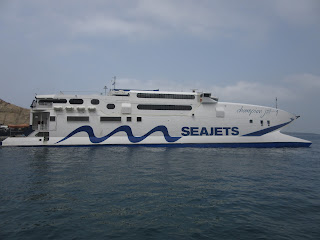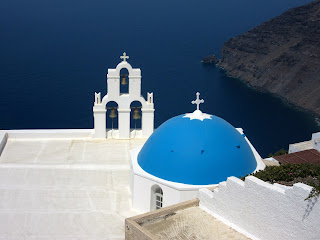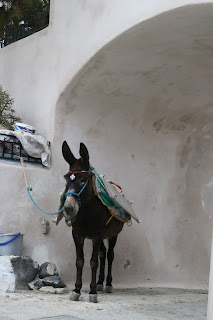A 4:30 wake up call, as today we breakfast, load luggage and head for the port for an early ferry to the island of Santorini. Emmie likes us to be early, as she says things in Greece don't always run on schedule.
We are taking a Blue Star ferry. There are several lines, but Blue Star seems the largest and most popular. There will be more options in a month or so when the peak tourist season begins.
Lots of vehicles and up to 2,000 people on this ferry! We have assigned seats which are fairly comfortable and Greg and I luck out with a window.
There are open decks as well and a business lounge with comfier seating (and a pricier ticket). It will be about a five hour trip with brief stops in Mykonos and Naxos along the way.
There are dozens of islands along the way, some tiny and uninhabited.
Here is our first look at Naxos from the ferry. We will head there later on our own.
We read, talk and nap, taking a few photos along the way.
We approach Santorini across the huge water-filled caldera formed from the earthquake that re-shaped the island. There are two smaller adjacent islands which are dark volcanic rock. Some people think Santorini may be the lost island of Atlantis. We exit the boat with hoards of others who take no note of the posted sign....
re-board the bus and head to the town of Fira (also called Thira ). The island was named Phira or Thira by the Greeks but changed to Santorini by the Venicians, who established a naval base here. Santorini is shaped kind of like a backward C and Fira is a little north of midway.
The streets are busy and narrow, with buses of all sizes, vans, cars, four-wheelers and assorted motorcycles and scooters. Scooters and motorcycles often tend to make their own route among the others and here, as elsewhere in Greece, it is "pedestrians beware" as pedestrians definitely
 don't have the right of way and sidewalks and guardrails are rare. Some places do have orange markers along the road indicating a walking aisle. Drivers are often seen driving in reverse when maneuvering for parking!
don't have the right of way and sidewalks and guardrails are rare. Some places do have orange markers along the road indicating a walking aisle. Drivers are often seen driving in reverse when maneuvering for parking!The hotel seems nice enough and is only a few blocks from the main part of town. This is the central courtyard.
Much of the town is built on the hills and cliffs, so our calf muscles have been getting quite a workout!
Emmie takes us to a few spots to show us a fast-food type area and then along the warren of pedestrian streets to a fort overlooking the harbor. Indeed the water is visible from much of the town. Then we are on our own till a 3:30 bus tour.
There are dozens of shops selling jewelry, clothing, souvenirs and more. Handmade sandals seem a hot item.
This quaint bookstore was interesting - it had sections in English, Dutch, German and others as well as Greek.

I take it this was the Cat for Rent referenced on the sign outside.
We walk and then share a lamb gyro at Nicks before going back to the hotel for some r&r. Nick, Nicos and Nicholas seem by far the most popular men's name.
Some places add french fries IN their gyros.
Our bus tour guide is Hara, a lovely, energetic woman, here shown with Emmie (the blond).
She tells us Santorini has about 15,000 residents in 13 villages, but during high season it is more like 22,000 residents as many come to work the tourist trade. From what we understand, pay is a little higher on the islands than in Athens and mainland. Housing for the workers is difficult, though.
Santorini has vineyards, but the plants here are trained to grow close to the ground, with the winding, basket-like vines and leaves protecting the grapes from the heat and winds. Their water comes from the morning dew and humidity. The most well known wine is Assyrtiko, a white wine.
There was a 7.5 earthquake here in 1956, so instead of stone, most houses were built of concrete after that, covered with a stucco like coating. They are whitewashed once a year in the Spring. We saw this man doing some touch-up on his place.
Our tour takes us to Akrotiri, an archeological site discovered by a farmer in 1967 and still being excavated. It is under cover now and slowly being worked on as funding is available. Universities from Germany, the US and others are helping. The level we see is from the 2nd millennium B.C. and apparently was abandoned before the crushing earthquake that covered it and created the caldera. No skeletons or evidence of bodies. The ash from this earthquake has been found as far away as the Sequoia trees in California. There were multi-story structures with furniture, cooking pots, etc. The big white poles are the support system for the roofing, but also give access lower down.
Rooms were colorfully painted and we will see some of the removed frescoes and other items that have been recovered at a small museum in town later.
AND there is evidence of previous occupation of this area in at least two layers under this one. The depth of history here continues to amaze.
Hara points out some low growing caper plants near the site. The capers are large here and they put them in many dishes, and use the leaves in cooking as well.
On the way back to town we stop at a small village called Pyrgos, Hara's home town. Many of our group go a taverna to taste wine but Greg and I decide to explore a bit. Pyrgos is built on a hill and at the top we can see two churches, so we head that way. There are no roads for traffic in most of the town, only narrow paved pathways that twist and wind from house to house. Most but not all are well maintained.
Part way up we see this donkey, patiently waiting for something or someone. Some little children come by and feed it a piece of bread.
Space seems to be at a premium, but this home has a nice courtyard area.
We make it to the churches but are quite turned around by then, so we just go downward till we hit the main road which seems to circle the base of the hill. Except we have no clue which way to turn to get to the bus and can no longer see the churches! We know we got off the bus not far from a high school, so stop and ask a man the way to the school. He speaks no English. We walk a bit and see two younger men, so try again. Petros (Peter) speaks English well, thankfully, but apparently there are several schools, so he invites us into his car to drive us to find the bus! He says he travels and often gets lost, so is happy to help us! What a nice guy! We don't go very far before we spot the bus - with a few minutes to spare before our departure time. Whew!
Next, we drive to the highest point on the island where there is a monastery, but the fog has rolled in big time. Here is Steve standing where there should be a panoramic view of the island.
The wind occasionally shows us a glimpse of a town below.
And once again we are happy that we aren't driving!
Back in Fira, we buy some bottled water at a small grocery store near the hotel - about 50 cents a bottle. And a bottle of Assyrtiko. Everyone drinks bottled water here and this has been true of more than half of the places we've stayed. After a shower and rest, we head out for dinner on our own. Since there isn't a spectacular view of the caldera due to haze and clouds, we opt for an off- the- main-road place called Mama's instead of paying for a view. We try a traditional appetizer dip called fava which is made from yellow peas - not fava beans - topped with capers, onions, olives, tomato, and small fish. Rather like hummus and we eat it with pita bread. It is quite good! Greg loves his Rabbit (with potatoes of course), while I enjoy a pasta dish with chunks of lamb.
Silverware often comes with the breadbasket.
Santorini is famous for it's sunsets, but not this night. As someone tells us later, it is hazy and a little cloudy because the winds are from the south now. It is chilly and quite windy as we wait to see if the sun will break through, but it disappears before it can reach the horizon. Indeed, we have experienced a lot of haze in most areas of Greece, especially early morning and evening over the water. They are quick to point out that it is NOT pollution, just humidity and weather patterns.
Walk back to our hotel. Hearing all kinds of languages en route.
We can add painted donkeys to our list of painted animals we have seen in our travels: dolphins, fish, groundhogs, pelicans, cows, horses, bears, bison, moose ...
Bedtime comes early after figuring out the shower and toilet. Nearly every place has its own set up, so you push buttons, turn levers, pull things or push plungers....whatever. Greg usually showers first and figures it out so I have it easy!



















































No comments:
Post a Comment